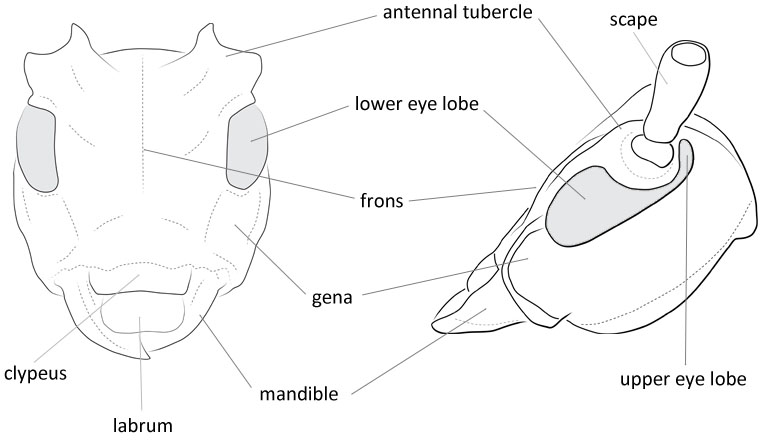Body length: 8–12 mm.
Eyes: eye interommatidial setaeseta:
a sclerotized hair-like projection of the cuticle
absent, eye deeply emarginateemarginate:
notched at the margin > half width or divided-max one row of facets between, eye ommatidial density fine.
> half width or divided-max one row of facets between, eye ommatidial density fine.
Antennaeantenna:
in larval and adult insects, paired segmented appendages, borne one on each side of the head, functioning as sense organs and bearing a large number of sensilla
: antennal length reaches between basebase:
the part of any appendage or structure that is nearest the body
and end of elytraelytron:
the leathery forewing of beetles, serving as a covering for the hind wings, commonly meeting opposite elytron in a straight line down the middle of the dorsum in repose
or reaching/surpassing end of body, antennal flagellar segments elongateelongate:
much longer than wide
, scapescape:
the first proximal segment of the antenna smooth/punctate at apexapex:
smooth/punctate at apexapex:
end of any structure distad to the base
, antennal scapescape:
the first proximal segment of the antenna ≥ segment 3 or segment 3 > scapescape:
≥ segment 3 or segment 3 > scapescape:
the first proximal segment of the antenna .
.
Pronotumpronotum:
the upper and dorsal part of the prothorax
: pronotumpronotum:
the upper and dorsal part of the prothorax
shape transversetransverse:
broader than long
, pronotumpronotum:
the upper and dorsal part of the prothorax
lateral armature absent.
Prosternum: prosternal processprosternal process:
a posterior extension of the prosternum between the coxae dilated at apexapex:
dilated at apexapex:
end of any structure distad to the base
or not dilated at apexapex:
end of any structure distad to the base
, procoxal cavities open posteriorly.
Elytraelytron:
the leathery forewing of beetles, serving as a covering for the hind wings, commonly meeting opposite elytron in a straight line down the middle of the dorsum in repose
: elytral length reaching or close to end of abdomen, elytral apicesapex:
end of any structure distad to the base
rounded or truncatetruncate:
cut off squarely at the tip
, elytral color black, brown, reddish, orange, rarely metallic, elytral color pattern absent.
Legs: visible tarsomerestarsomere:
subdivision or article of the tarsus, usually numbering from two to five : 4, femora clavateclavate:
: 4, femora clavateclavate:
thickening gradually toward the tip
, protibial spursprotibial spur:
sclerotized spine(s) located at the distal tibia; can be single, double, or absent : 2, tarsal clawstarsal claw:
: 2, tarsal clawstarsal claw:
usually paired claws of the pretarsus, at the distal end of the leg simple.
simple.
Form moderately broad, slightly flattened. Head scarcely impressed between antennal bases; antennaeantenna:
in larval and adult insects, paired segmented appendages, borne one on each side of the head, functioning as sense organs and bearing a large number of sensilla
slender, longer than body in male, 11-segmented in both sexes, segments cylindricalcylindrical:
shaped like a cylinder, parallel sided
, not flattened nor expanded, second segment at least 1 1/2 times as long as broad; third segment a little longer than fourth; palpi with last segment truncatetruncate:
cut off squarely at the tip
at apexapex:
end of any structure distad to the base
. Pronotumpronotum:
the upper and dorsal part of the prothorax
evenly rounded at sides; surface finely punctured; discal callosities feeble; prosternal processprosternal process:
a posterior extension of the prosternum between the coxae narrow, expanded behind coxae in male, broad in female; mesonotum with a large, undivided, finely tessellate stridulatory plate; intercoxal process of mesosternummesosternum:
narrow, expanded behind coxae in male, broad in female; mesonotum with a large, undivided, finely tessellate stridulatory plate; intercoxal process of mesosternummesosternum:
sternum of the mesothorax
broad, emarginateemarginate:
notched at the margin posteriorly. Femora strongly clavateclavate:
posteriorly. Femora strongly clavateclavate:
thickening gradually toward the tip
; posterior tarsitarsus:
the leg segment distal to the apex of the tibia, bearing the pretarsus; consists of one to five tarsomeres (including pretarsus)
slender, first segment but little longer than following two together, claws simple (Linsley 1964Linsley 1964:
Linsley EG. 1964. The Cerambycidae of North America. Part V. Taxonomy and Classification of the Subfamily Cerambycinae, Tribes Callichromini Through Ancylocerini. University of California Publications in Entomology, Vol. 22. 197 pp.).
Semanotus, Callidium, Callidium (Palaeocallidium)
This genus is related to Semanotus but has strongly clavateclavate:
thickening gradually toward the tip
femora, antennaeantenna:
in larval and adult insects, paired segmented appendages, borne one on each side of the head, functioning as sense organs and bearing a large number of sensilla
with the second segment longer (at least 1.5x as long as broad), and the pronotumpronotum:
the upper and dorsal part of the prothorax
with the surface finely punctured and discal callosities weak. New World species seem to have eyes less divided. Callidium has a prosternal processprosternal process:
a posterior extension of the prosternum between the coxae that attenuates between the coxae and a pronotumpronotum:
that attenuates between the coxae and a pronotumpronotum:
the upper and dorsal part of the prothorax
that widens anteriorly. Callidium (Palaeocallidium) has weakly clavateclavate:
thickening gradually toward the tip
femora and a pronotumpronotum:
the upper and dorsal part of the prothorax
that widens anteriorly.
Nearctic, eastern Palearctic; C. rufipenne introduced in Europe, North America, Argentina
Cupressus, Chamaecyparis, Juniperus, Thuja, Thujopsis, Cryptomeria, Hesperocyparis macrocarpa, Taxus cuspidate, Cunninghamia lanceolate, Taiwania cryptomerioides; Abies, Larix, Picea, Pinus
Callidiellum Linsley, 1940